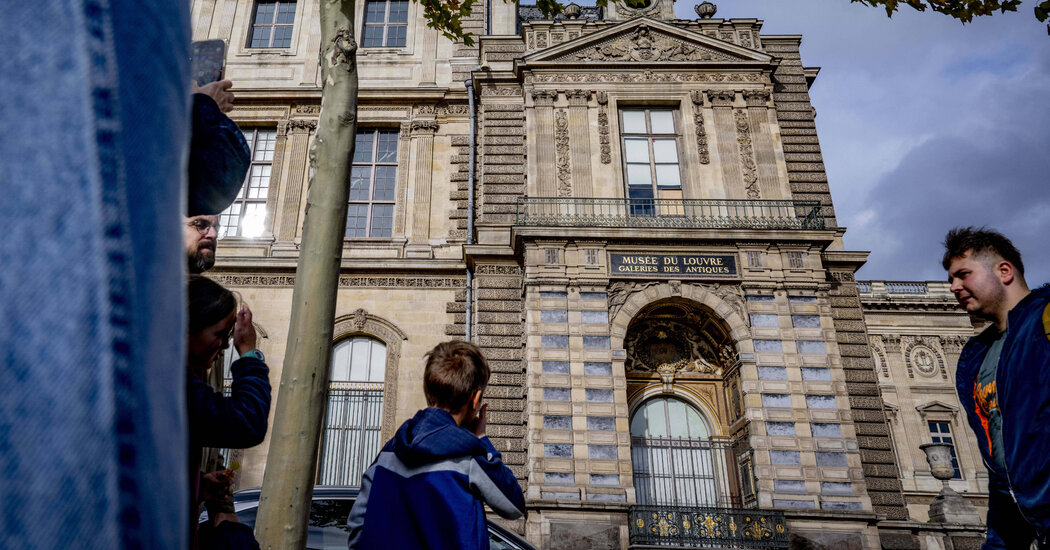They’ve cased a few joints in their criminal careers. Even swallowed diamonds and done time.
So what do former jewelry thieves make of the brazen heist that the entire world can’t stop talking about?
Could they have pulled it off? Was it a criminal stroke of genius or sheer luck resulting from a museum’s master class in incompetence?
Some gave their, ahem, professional insight into last Sunday’s break-in at the Louvre in Paris, where intruders breached a second-floor window of the world’s most-visited museum and got away with more than $100 million in royal jewels and crown diamonds.
In no more than seven minutes. Take that, “Ocean’s Eleven.”
“I know the adrenaline rush,” said Larry Lawton, who served more than 11 years in federal prison for a string of jewelry store robberies on the East Coast in the 1980s and 1990s. “I know how you have to time it. You can get discombobulated if you don’t understand what you’re doing.”
Mr. Lawton, 64, whom the authorities connected to more than $18 million in stolen jewels, said he was asleep at his home in Florida when a friend called to say that the famed museum had just been hit.
“The first thing people got to know, you have to know you can get away with it before you rob it,” said Mr. Lawton, whose memoir, “Gangster Redemption,” traced his passage from criminal to motivational speaker and criminal justice reform advocate.
Back in the day, he said, he would case jewelry stores ahead of time to detect vulnerabilities and weigh risks. Then, in his telling, he would strike, brandishing a BB gun and using zip ties to restrain the owners while he absconded with the loot.
Any thief worth his or her salt, he said, would know to have a fence lined up in advance to unload the stolen jewels.
Mr. Lawton said that it was no fluke that the Louvre thieves knew to target the gilded Galerie d’Apollon, where the jewels were kept in cases. They used a truck-mounted electric ladder, known as a monte-meubles, to access the gallery, and grinders to break a window.
“Let me tell you, they had an inside person,” he said. “An inside person doesn’t mean they even know him. Could it be a girlfriend who’s a tour guide, and she knows, oh, where it is?”
Mr. Lawton said that the most successful thieves know when to pounce and when to cut bait.
“I was going to rob the Fontainebleau hotel,” he said of the Miami Beach resort. “Mega job. And I called it off after casing for six, eight weeks, you know, because it wasn’t right.”
Joan Hannington, 69, who gained notoriety in the London underworld during the 1980s as a prolific diamond thief, swallowing jewels and earning the nickname “the Godmother,” said that the crew that hit the Louvre appeared to have detailed knowledge of security lapses.
“It’s got to be an inside job,” Ms. Hannington said in a phone interview from her home in West Sussex, England.
Her memoir, “Joan: The true story of how I became Britain’s most notorious diamond thief,” was adapted into a 2024 television mini-series on ITV starring Sophie Turner.
Ms. Hannington said that it should not be difficult for the thieves to unload the gems from the Louvre.
Their haul included eight precious objects, including a royal sapphire necklace, a royal emerald necklace and its matching earrings, and a diadem worn by Empress Eugénie, the wife of Napoleon III, France’s 19th-century ruler.
“They can break them all up and sell the individual stones,” she said. “They can be made into rings.”
Ms. Hannington, who served about two-and-a-half years in prison during the 1970s — not for jewelry heists, but for check fraud — ridiculed the French authorities and the Louvre. Both have drawn intense scrutiny over their responses to the break-in and security at the museum, which had not insured the stolen jewels, citing prohibitive costs.
“Where I come from, if you’ve got that amount of diamonds or jewelry or artifacts or whatever, and you’re not insured, shame on you,” Ms. Hannington said. “They couldn’t catch a fart in the wind. How stupid are they?”
While Mr. Lawton similarly faulted the museum, he said that the heist was far from a flawless operation. The thieves ditched gloves, a helmet, vest and other items that the authorities have said contained traces of DNA.
“They’re not experts,” he said. “They’re opportunists.”
Even more shocking to him: During their getaway, the thieves hastily dropped a crown made for Empress Eugénie to wear during the Universal Exposition in Paris in 1855.
“I robbed 25, 30 jewelry stores — 20 million, 18 million, something like that,” Mr. Lawton said. “Did you know that I never dropped a ring or an earring, no less, a crown worth 20 million?”
His advice to the thieves?
Get out of France if they have not done so already. Although traveling by airplane is a risky proposition, Mr. Lawton said, there are ways to smuggle jewels through airport security.
“It’s call suitcasing,” he said. “It’s when you hide something in your rectum.”
Ms. Hannington, who worked for some jewelry stores that she stole from, said she would sometimes swallow the gemstones with olive oil.
“It goes through the system,” she said. “We don’t have to get too graphic.”
She, too, could not fathom how the thieves had left the crown behind.
“A good thief is like a Hoover,” she said. “They Hoover all the diamonds up.”
Mr. Lawton said that it seemed like only a matter of time until the thieves were caught and prosecuted, unless they keep some of the jewels as bargaining chips.
“You can bury diamonds forever,” he said.
The choreography of the Louvre heist left some real-life criminals less than impressed. But the actor George Clooney, known for playing a big-time thief (Danny Ocean) on the big screen, told Variety this week that the theft was straight out of a Hollywood script.
He had been teasing the production of “Ocean’s 14.”
“It was cool, though,” Mr. Clooney said. “I mean, it’s terrible. But if you’re a professional thief like I am, I was very proud of those guys.”
Neil Vigdor covers breaking news for The Times, with a focus on politics.
The post ‘It’s Got to Be an Inside Job’: Jewelry Thieves Weigh In on Louvre Heist appeared first on New York Times.




